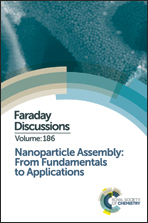How do polydisperse repulsive colloids crystallize?
Abstract
A modified version of the Gibbs-ensemble Monte-Carlo method reveals how polydisperse charged colloidal particles can build complex colloidal crystals. It provides general rules that are applicable to this fractionated crystallization that stems from size segregation. It explains the spontaneous formation of complex crystals with very large unit-cells in suspensions of nanoparticles with a broad size distribution.
- This article is part of the themed collection: Nanoparticle Assembly: From Fundamentals to Applications

 Please wait while we load your content...
Please wait while we load your content...